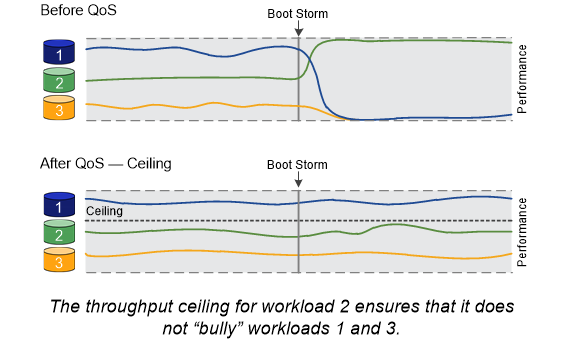Load balancing
Performance of workloads begins to be affected by latency when the amount of work on a node exceeds the available resources. You can manage an overloaded node by increasing the available resources (upgrading disks), or by reducing load (moving volumes or LUNs to different nodes as needed).
You can also use ONTAP storage quality of service (QoS) to guarantee that performance of critical workloads is not degraded by competing workloads:
You can set a QoS throughput ceiling on a competing workload to limit its impact on system resources (QoS Max).
You can set a QoS throughput floor for a critical workload, ensuring that it meets minimum throughput targets regardless of demand by competing workloads (QoS Min).
You can set a QoS ceiling and floor for the same workload.
Throughput ceilings
A throughput ceiling limits throughput for a workload to a maximum number of IOPS or MB/s. In the figure below, the throughput ceiling for workload 2 ensures that it does not bully
workloads 1 and 3.
A policy group defines the throughput ceiling for one or more workloads. A workload represents the I/O operations for a storage object: a volume, file, or LUN, or all the volumes, files, or LUNs in an SVM. You can specify the ceiling when you create the policy group, or you can wait until after you monitor workloads to specify it.

Throughput floors
A throughput floor guarantees that throughput for a workload does not fall below a minimum number of IOPS. In the figure below, the throughput floors for workload 1 and workload 3 ensure that they meet minimum throughput targets, regardless of demand by workload 2.
A workload represents the I/O operations for a volume, LUN, or, starting with ONTAP 9.4, file. A policy group that defines a throughput floor cannot be applied to an SVM. You can specify the floor when you create the policy group, or you can wait until after you monitor workloads to specify it.

Adaptive QoS
Ordinarily, the value of the policy group you assign to a storage object is fixed. You need to change the value manually when the size of the storage object changes. An increase in the amount of space used on a volume, for example, usually requires a corresponding increase in the throughput ceiling specified for the volume.
Adaptive QoS automatically scales the policy group value to workload size, maintaining the ratio of IOPS to TBs|GBs as the size of the workload changes. That's a significant advantage when you are managing hundreds or thousands of workloads in a large deployment.